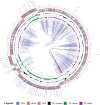Genomic analysis and immune response in a murine mastitis model of vB_EcoM-UFV13, a potential biocontrol agent for use in dairy cows
- PMID: 29717158
- PMCID: PMC5931544
- DOI: 10.1038/s41598-018-24896-w
Genomic analysis and immune response in a murine mastitis model of vB_EcoM-UFV13, a potential biocontrol agent for use in dairy cows
Abstract
Bovine mastitis remains the main cause of economic losses for dairy farmers. Mammary pathogenic Escherichia coli (MPEC) is related to an acute mastitis and its treatment is still based on the use of antibiotics. In the era of antimicrobial resistance (AMR), bacterial viruses (bacteriophages) present as an efficient treatment or prophylactic option. However, this makes it essential that its genetic structure, stability and interaction with the host immune system be thoroughly characterized. The present study analyzed a novel, broad host-range anti-mastitis agent, the T4virus vB_EcoM-UFV13 in genomic terms, and its activity against a MPEC strain in an experimental E. coli-induced mastitis mouse model. 4,975 Single Nucleotide Polymorphisms (SNPs) were assigned between vB_EcoM-UFV13 and E. coli phage T4 genomes with high impact on coding sequences (CDS) (37.60%) for virion proteins. Phylogenetic trees and genome analysis supported a recent infection mix between vB_EcoM-UFV13 and Shigella phage Shfl2. After a viral stability evaluation (e.g pH and temperature), intramammary administration (MOI 10) resulted in a 10-fold reduction in bacterial load. Furthermore, pro-inflammatory cytokines, such as IL-6 and TNF-α, were observed after viral treatment. This work brings the whole characterization and immune response to vB_EcoM-UFV13, a biocontrol candidate for bovine mastitis.
Conflict of interest statement
The authors declare no competing interests.
Figures







References
-
- Shaheen M, Tantary H, Nabi S. A Treatise on Bovine Mastitis: Disease and Disease Economics, Etiological Basis, Risk Factors, Impact on Human Health, Therapeutic Management, Prevention and Control Strategy. Adv. Dairy Res. 2016;4:1–10.
-
- Zeinhom MMA, Abdel-Latef GK. Public health risk of some milk borne pathogens. Beni-Suef Univ. J. Basic Appl. Sci. 2014;3:209–215.
Publication types
MeSH terms
Substances
LinkOut - more resources
Full Text Sources
Other Literature Sources

